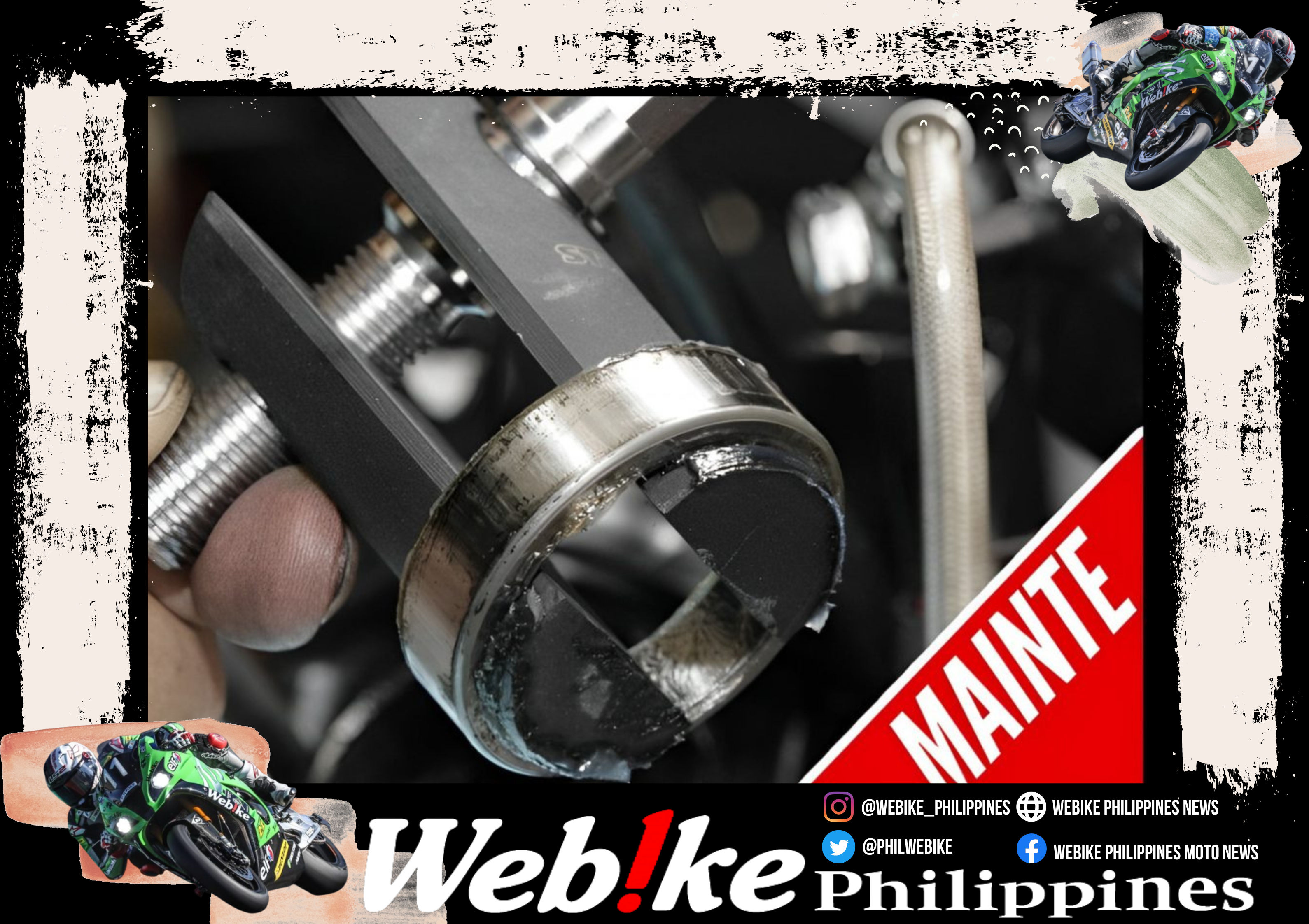The condition of the steering stem bearings is an important factor that has a significant impact on the handling of the bike. Even a small ding in the race can cause discomfort, so it needs to be replaced, but the tools required may differ between ball bearings and tapered roller bearings. In the case of tapered roller-bearing vehicles, the lack of just one tool can bring work to a halt.
The inner diameter of the race press fitted into the head pipe changes the degree of difficulty when punching out.

After removing the handlebars, meter, and top bridge, the upper bearing can be checked by removing the top threaded nut. By removing the front tires and front forks, which have a large inertia weight, the condition of the stem nut can be more easily determined. Although there is no fix for dents in the bearing race, the top thread may loosen due to shock from a fall or other cause, and the preload on the bearing may weaken, resulting in rattling. In such cases, retightening the top thread may eliminate the discomfort.

The outer race is dented and dented by the tapered roller being pressed hard against it. When the tapered roller rides over this area, it gets caught and prevents smooth steering operation. Even if the race is corroded due to a lack of grease, the roller can still get caught, so daily maintenance is important even if there is no external cause such as a fall.

This is the outer race of the ball bearing. Because of the large difference between the outer and inner diameters, the flange protrudes from the inside of the head pipe, and it is easy for iron pipes and taggers to get caught on the backside. If you strike one spot intensively, the race will tilt and bite into the head pipe, so strike evenly around the circumference.
To maintain a delicate balance, the steering wheel moves left and right not only when cornering but also when riding straight. Therefore, if the bearings are damaged due to a fall or impact, handling will be adversely affected, such as a feeling of being stuck at a certain steering wheel angle.
There are two types of steering stem bearings: ball bearings that use steel balls and tapered roller bearings that use conical rollers. It is used with a ball or tapered roller sandwiched between them.
A typical example of stem-bearing damage is a ding in the outer/inner race. The two races and ball or tapered rollers operate smoothly with proper clearance. However, if the stem shaft is pried through the lower bracket due to excessive force applied to the front fork, such as from a fall or excessive wheelie, the ball or tapered roller will be pressed against the race due to the strong diagonal force of the race and ball working against each other, causing a dent in the race and discomfort when turning the steering wheel to the left or right. This can lead to pulling and discomfort when turning the steering wheel to the left or right.
Once a race has been struck, it cannot be fixed naturally and must be replaced. And since stem bearings are press-fitted into the frame and stem shaft, hammering force is required. This is a major difference from general maintenance work, which involves attaching and removing parts fixed with bolts and nuts.
When pulling out the outer race that is press-fitted into the frame head pipe, insert a sufficiently strong steel pipe or bar from the bottom of the head pipe for the upper race and from the top of the head pipe for the lower race, and tap multiple points evenly aiming at the inner diameter of the outer race that protrudes inside the head pipe. Tap the inner diameter of the outer race protruding from the inside of the head pipe at multiple points. Be careful not to strike one point too intensively, as this will cause the race to tilt and bite into the head pipe and scratch the head pipe.
And the difficulty of outer race removal depends on the bearing type, with tapered roller bearings tending to be more difficult than ball bearings. The reason for this is the difference in race bore diameter.
In a ball bearing, the difference between the outer and inner diameters is large because the ball rolls on the racing surface and the inner diameter protrudes well inside the head pipe, making it easy for an iron pipe or steel rod striking the race to get caught. On the other hand, in a tapered roller bearing, the rolling surface of the tapered roller is on a slope, so the difference between the outer and inner diameters is less than in a ball bearing race, and the flange exposed on the inside of the head pipe is also less, making it more difficult for tools to get caught on it.
Some models have a notch on the inside of the head pipe to make it easier to hang a tool to tap out the outer race, but if the amount of flange is so small that the steel pipe or tugger strikes out, you are out of luck.
POINT
Point 1 - If a large force is applied to the stem shaft from the front fork due to a fall or impact, the steering stem bearing will be pried off and the outer race will be dented.
Point 2 - When removing the outer race of a stem bearing that is press-fitted into the frame head pipe, tapered roller bearings are often difficult to get a punching tool on.
A special tool, the race remover, makes it easier to pull out tapered roller bearings.

Insert the stem bearing race remover into the head pipe, turn the bolt making sure the claw at the tip is caught on the outer race, and press the two-part body against the outer race.

Insert an iron pipe or similar object from the opposite side of the head pipe and tap the lace remover itself. If the claws are not firmly attached to the outer race, and the lace comes off at the same time as the tapping is done, insert a wedge-shaped tip of a hammer into the gap between the remover and the race remover, so that the tapping force pushes the remover itself apart.

This image clearly shows how the pawl on the tip of the stem-bearing race remover is caught on the inner diameter of the outer race. If the amount of flange protruding inside the head pipe is small, the iron pipe and the tugger often do not get caught and swing out, but if the claw hangs over the entire circumference, it can surely be caught.

The outer race of a tapered roller bearing has a large inner diameter relative to the outer diameter. This means that the amount of flange protruding into the head pipe is reduced, making it difficult to use a tool to tap it out. If you have to use a stem-bearing race remover to remove the race, you cannot proceed with further work even after removing all the parts around the handlebar.

The inner diameter of the ball bearing outer races (the two in the center) is smaller than the outer diameter, and the amount of flange that protrudes inside when it is press-fitted into the head pipe increases. Therefore, even general-purpose tools such as iron pipes and chisels can easily be caught and punched out.

When safely removing the dented outer race and press-fitting the new part, the work proceeds while making sure that the race is not tilted. Since it may be difficult to notice any tilting of the race if a bearing installer is used from the beginning, a hammer is used to strike the race with a hammer against the race so that the condition of the race can be seen.

If it can be press-fitted from the entrance area without leaning in line with the head pipe, an installer may be used from the middle of the pipe. When the bottom of the outer race hits the head pipe, the hammering sound becomes high-pitched, so be careful not to miss the change in sound.
The stem bearing race remover is useful for removing the outer race of tapered roller bearings, which are difficult to pull out with tools and tools at hand because of the small difference between the head pipe's inner diameter and the outer race inner diameter.
This tool adjusts the distance between the two divided cylinders with a bolt, and the claw at the tip hooks onto the slight flange of the outer race to hold it in place. The outer race is then struck out by inserting a steel rod or other object from the opposite side of the stem pipe and striking the remover itself.
Even if the flange protrusion of the outer race bore is small, a race limber with a jaw hooked almost all the way around will increase the efficiency of striking force compared to an iron pipe or tagger that only hits with pinpoint accuracy.
The two-part jaws are extended with bolts to press against the race bore to prevent the tool from coming off when striking, which also helps ensure that striking force is transmitted.
Here, we used a Kawasaki W650 to remove the outer race, and the remover's claw firmly gripped the inner diameter of the outer race, allowing easy removal without escaping the force of blows. If you feel that the claws are too shallow, you may want to insert a wedge (a large size wedge) into the gap between the claws so that the claws expand with the force of the blows.
Even with the type of outer race that is caught by iron pipes or taggers, the advantage is that the jaws hang over the entire circumference of the race, making it difficult to tilt during removal. The outer race bore diameter of ball bearings tends to be smaller than that of tapered roller bearings, but Tool Shop Shop Straight has a lineup of two types of removers with different corresponding bore diameters.
However, on some models where the head pipe's inner diameter is smaller than the outer race's inner diameter, the remover cannot be used because it cannot be clawed. In such cases, some bike stores use a technique where they weld a piece of steel end material to the rolling surface of the tapered roller and strike the end material from the opposite side of the head pipe. This requires a welder and the skill to use it, but it is worth remembering that this kind of applied technique is necessary when the press-fitted outer race cannot be struck directly by any means.
POINT
Point 1 - A stem-bearing race remover with a cylindrical outer circumference and circumferential jaws makes it easy to pull out a tapered roller bearing with a small flange.
Point 2 - When the remover's claw comes off, you can ride a wedge into the gap in the body and tap it while apply force to open it outward.



